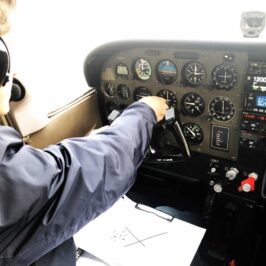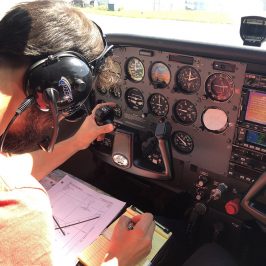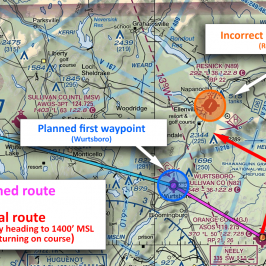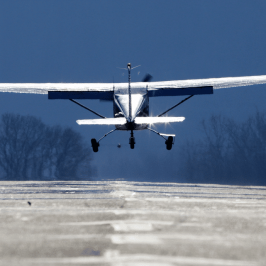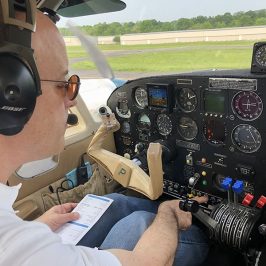Perhaps surprisingly, no, it doesn’t, and yes, the pilot may remove the navcom from the panel: Appendix A to 14 CFR Part 43(c), “Preventive maintenance,” allows for 31 tasks to be completed by the holder of a pilot certificate under part 61. Item 31 is…
(31) Removing and replacing self-contained, front instrument panel-mounted navigation and communication devices that employ tray-mounted connectors that connect the unit when the unit is installed into the instrument panel, (excluding automatic flight control systems, transponders, and microwave frequency distance measuring equipment (DME)). The approved unit must be designed to be readily and repeatedly removed and replaced… “
14 CFR §43 Appendix A, (c)(31)
… but, of course, this requires a careful review if something other than “self-contained, front instrument panel-mounted navigation and communication devices that employ tray-mounted connectors” need removal.
Bottom line, deactivation is something which can generally be accomplished by a person holding at least a private pilot certificate. Removal often involves maintenance or is outright prohibited under Appendix A, meaning that the operation requires an appropriately rated and certificated mechanic.
(And don’t forget, your Weight and Balance must be updated any time installed equipment weighing more than one pound is removed from the aircraft. Only an AMT can do that.)
Almost there
Now that the #2 navcom has either been removed or deactivated, placarded, and a logbook entry made by an authorized person, there’s still one last event which must take place.
The final step:
(4) A determination is made by a pilot, who is certificated and appropriately rated under part 61 of this chapter, or by a person, who is certificated and appropriately rated to perform maintenance on the aircraft, that the inoperative instrument or equipment does not constitute a hazard to the aircraft.
14 CFR §91.213(d)(4)
This is a regulatory provision which gives the pilot the authorization to make the final determination as to whether the aircraft is considered safe for flight, while not requiring acceptance of the aircraft unless the pilot deems the inoperative instrument or equipment does not constitute a hazard to the aircraft. Further, it allows the pilot to consider the type of operation to be conducted. For instance, although our example to this point assumes a Day VFR operation, what if it was in fact IFR and the aircraft’s only glideslope CDI was attached to the #2 navcom? An inoperative #2 navcom degrades the aircraft to nonprecision approach capability only and affects the pilot’s ability to select alternates under 14 CFR 91.167. Would that be a “hazard?” That’s up to the Pilot in Command.
Even under VFR, one operative navcom radio out of a normal complement of two might be enough of a hindrance that the PIC might consider the limitation to be a “hazard.” The point is, the determination may be made by the Pilot in Command.
We’re at the end of the flowchart – if the PIC accepts the aircraft with the inoperative #2 navcom after following the aforementioned steps:
Yes, the aircraft is airworthy per 14 CFR 3.5, 14 CFR 91.7 and 14 CFR 91.213(d).
Example 3
Let’s attempt to apply knowledge with this last example. In this final scenario, the pilot is flying a Piper Twin Comanche, a PA-30. During her pre-flight inspection, the pilot discovers that the stall warning indicator appears to be inoperative. May the issue be addressed under 14 CFR 91.213(d)?
Moving quickly through 14 CFR 91.213(d)(2), which mirrors the flowchart provided above, we can quickly eliminate a number of possibilities at first glance… there’s no MEL for this aircraft; the aircraft’s equipment list (no KOEL was published by the manufacturer) does not indicate that the stall warning indicator is required; 14 CFR 91.205(b) does not require a stall warning indicator to be functional; 14 CFR 91.207 is inapplicable (ELT); and there are no ADs for the stall warning indicator per the FAA Airworthiness Directives page. This leaves the TCDS, the second “box” on the flowchart. Searching for the PA-30 brings up Type Certificate Data Sheet No. A1EA.
Page 6 of No. A1EA includes this note:
Equipment: The basic required equipment as prescribed in the applicable airworthiness regulations (see Certification Basis) must be installed in the aircraft for certification. In addition, the following items of equipment are required:
(a) Stall warning indicator installation in accordance with Piper Dwg. 23945 and 23700 for Model PA-30, Serial Nos. 30-1 through 30-1716 and 30-1718 through 30-1744.
TCDS No. A1EA, PA-30
(b) Stall warning indicator installation in accordance with Piper Dwg. 26658 and 26651 for Model PA-30, Serial Nos. 30-1717 and 30-1745 through 30-2000.
No. The aircraft is unairworthy as it does not conform to its type design, in the form of its VFR-Day Type certificate requirements.
This is an appropriate example in which inoperative equipment that is not required by 14 CFR 91.205 cannot be “deactivated or removed” per 91.213(d). The VFR-Day Type Certificate requirements do not allow the aircraft to be flown except under the issuance of a Special Flight Permit per 14 CFR 21.197.
Thank you for reading. Please feel free to reach out with questions or comments.
-Ryan

